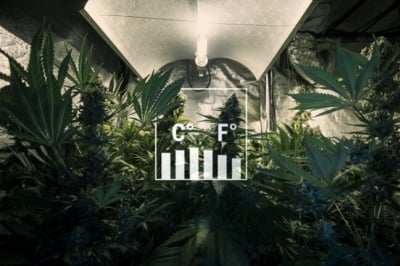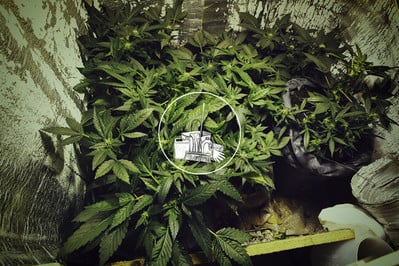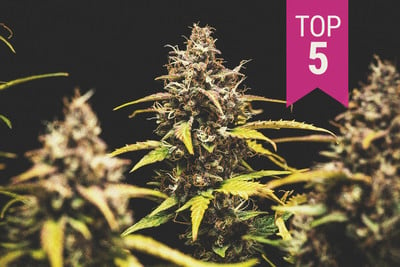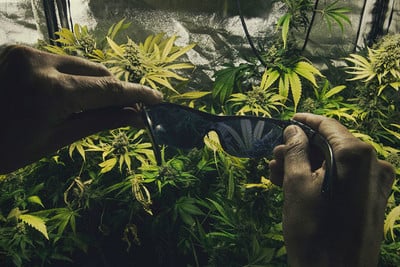Included FREE items

How To Use CO₂ To Increase Cannabis Yields
Plants need light, water, and CO₂ to conduct photosynthesis and create energy. By boosting levels of light and CO₂, you can increase the productivity of this process, leading to faster growth, bigger flowers, and better yields. There are many methods you can choose from to increase CO₂ levels, from complex tanks to simple DIY methods.
Contents:
- How cannabis plants use co₂
- Pros and cons of co₂ implementation
- When should you use co₂?
- How to use co₂ during the vegetative and flowering stages
- How much co₂ should I use in my cannabis grow room?
- How to add co₂ to your grow room
- Types of co₂ systems
- Metabolic and chemical options
- How to make your own diy co₂ system at home
Carbon dioxide (CO₂) has become a dirty word over the past few decades. Whenever we hear it, thoughts of car exhausts and climate change spring to mind. But millions of years before we pumped out huge quantities into the atmosphere, nature relied upon this molecule to fuel systems of life, as it does today.
Plants rely on CO₂ in the same way that we humans depend on oxygen. They use this gas to carry out crucial physiological functions. In fact, they rely on CO₂ so much that higher concentrations result in higher productivity.
Cannabis growers already amplify variables found in nature to improve the health, size, and yield of their plants. They string up powerful lights, feed their crop condensed nutrients, introduce plenty of beneficial microbes, and even instal fans to mimic the wind.
Cultivators can also manipulate the air within their growing space to improve the status of their plants. By adding more CO₂ to the microenvironment, they can produce more luscious growth, which results in better yields.
How Cannabis Plants Use CO₂
Cannabis plants use CO₂ to carry out photosynthesis—the process that converts light into energy.
Inhalation and Exhalation
For a cannabis plant to use CO₂, it must “breathe” it in. CO₂ enters the atmosphere as humans and other animals inhale oxygen and exhale carbon dioxide. Plants extract the gas from the air through the act of respiration.
Instead of a pair of lungs, plants are equipped with tiny spores on the surface of their leaves called stomata. Whereas we rely on our diaphragm to actively force air into our lungs, plants open and close these holes using guard cells that regulate stomata using water pressure.
CO₂ During Photosynthesis
As these tiny holes open, oxygen and water diffuse out and CO₂ passively diffuses into the plant. From here, CO₂ enters specialised cells called chloroplasts. Pigments within these cells harvest sunlight and use this energy to create sugars.
Harnessing the energy of the sun, plants use CO₂ and water (H₂O) to create glucose (sugar) and oxygen (O₂). They release the oxygen back into the atmosphere and utilise the sugars to power their cells.
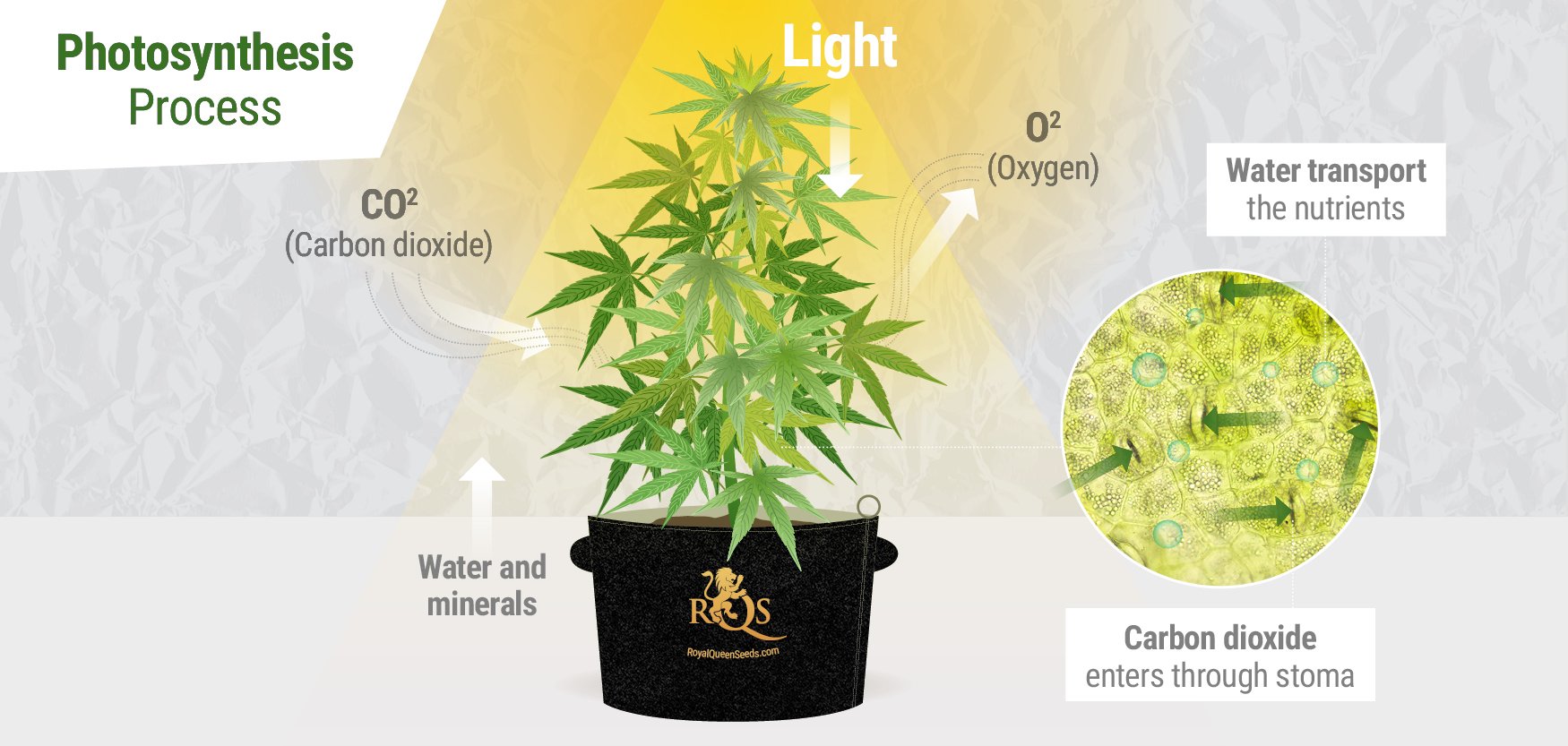
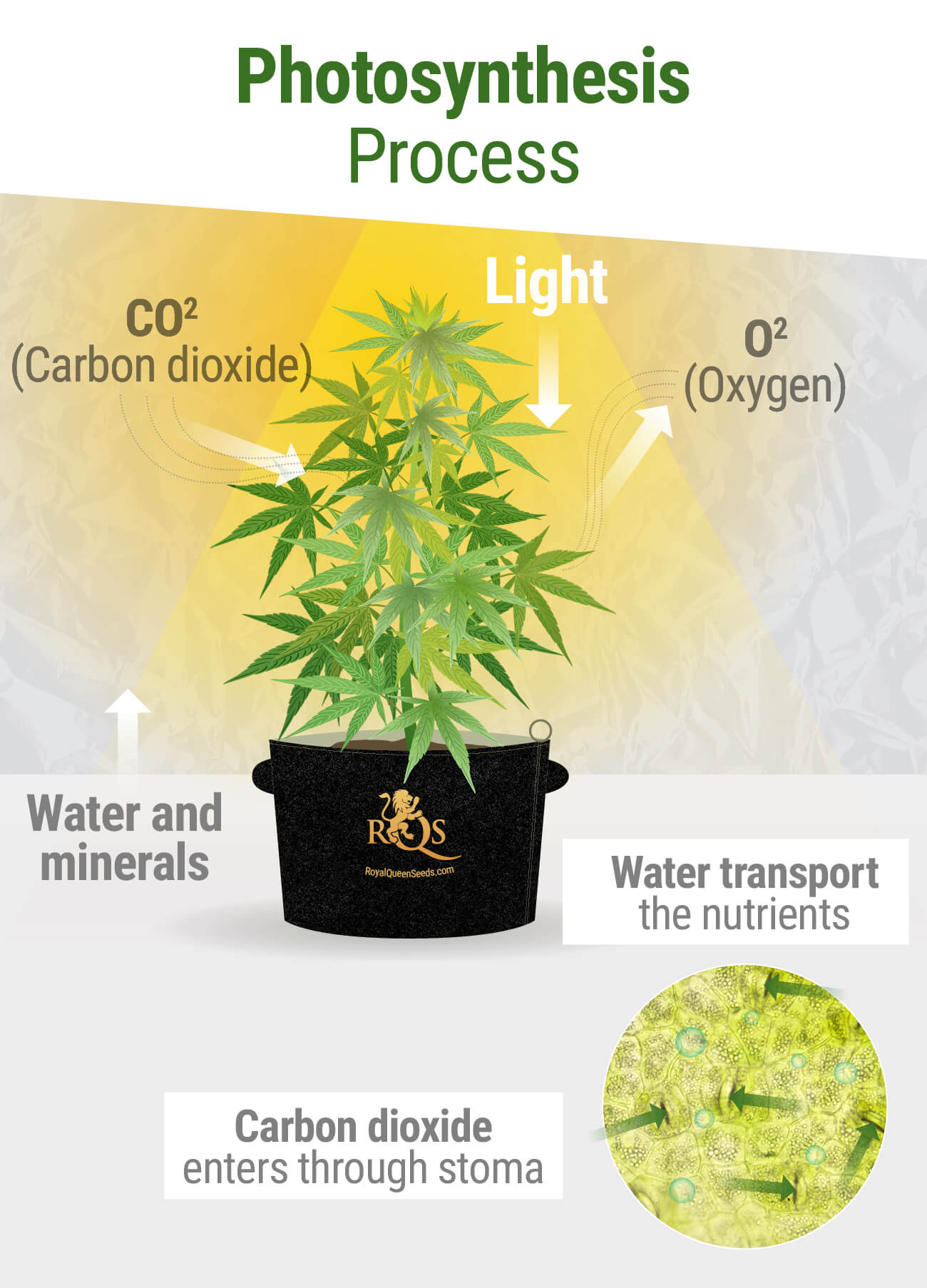
How Light, Temperature, and CO₂ Make Cannabis More Efficient
If you decide to start pumping CO₂ into your grow room, you need to take several other factors into account. Your plant won’t just willingly take in as much CO₂ as possible from the environment. They need more powerful lights and higher temperatures to whet their appetite.
These days, the atmosphere contains CO₂ at levels of around 400ppm (parts per million). However, as plants started to cross the bridge from sea to land, CO₂ levels hovered within an astonishing range of 3000–9000ppm!
Plants certainly evolved with the capacity to use a lot of CO₂, and they’ve maintained some of this ability. Cannabis, among other species, is able to utilise CO₂ at levels of 1500ppm to drive photosynthesis. This figure serves as the saturation point within a growing tent if you really want to maximise your yields.
But CO₂ only satisfies one piece of the photosynthesis puzzle. Plants can have all the CO₂ in the world, but without additional light, they won’t make much use of it. By using intense lighting, you’ll increase your plant’s demand for the gas.
You should aim to supply your growing tent with between 7,000–10,000 lumens per square foot (75,000–107,000 per square metre). To achieve this, you’ll need a 600W HPS or LED light in a 3 × 3' (approximately 1 × 1m) grow tent. Use a lux meter to ensure your lights are providing the right intensity.
With more light and greater levels of CO₂ in the air, plants can also benefit from higher temperatures. Typically, cannabis thrives at a temperature of around 25°C. An increase in CO₂ and light intensity allows growers to nudge the thermostat up to 30°C.
Known as the thermal optimum[1], this helps the enzymes that carry out photosynthesis go into overdrive. But be careful not to exceed this temperature. A few degrees higher and these crucial enzymes will start to denature, and you’ll increase the risk of heat stress.
Pros And Cons Of Co₂ Implementation
It is important to mention that before supplementing your operation with magical CO₂, every other requirement for growing healthy plants should be met. CO₂ will have insignificant or even damaging effect when exposed to unhealthy or nutrient hungry plants. So the best result you can get from CO₂ is when it’s added to a previously optimized setup with plenty of light power. Well fed, healthy plants with some LST training are set for large yields by that alone, and will certainly benefit the most from CO₂.
PROS:
-
Increase In Yields And Faster Growth
One of the more obvious reasons for adding CO₂ to a grow setup is to squeeze that extra juice from the nutrients and make your plants grow fast and big. Some growers reported a 20% increase in yields and speed of plant maturation. These numbers can only be achieved when every other need of a plant is met and with a maxed out light intensity for the grow area. The most notable increase in growth shows when plants are in the vegetative stage, but many growers are using CO₂ all the way to harvest.
-
Resistance To Environmental Stress
Plants exposed to 1000-1500ppm of CO₂ saturation will be able to endure higher growing temperatures of up to 30-35°C. This works hand in hand with bright lights that are needed for CO₂ supplementation. Such lamps produce much more heat than low powered CLF’s or LED lamps, and CO₂ negates that undesired effect which is often encountered in non-CO₂ setups.
-
Security Bonus
The majority of CO₂ injection methods require a sealed growing room without any air, or in this case, CO₂ leaks. This also stops any unwanted marijuana smell venting out, adding to the security of your grow space. Also, CO₂ generators burn natural gas as a process of releasing CO₂, producing smell on its own and conveniently masking the smell of blooming marijuana.
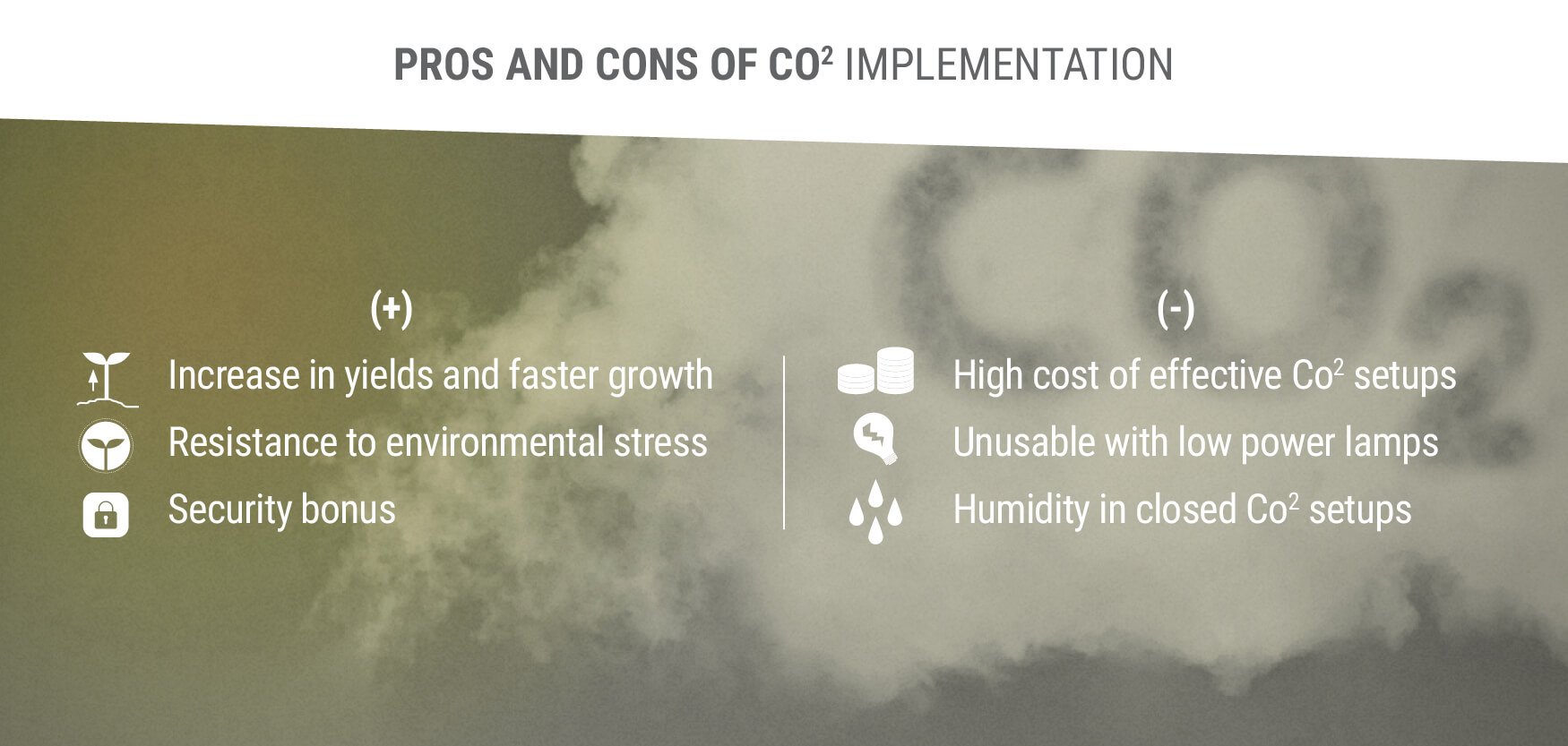
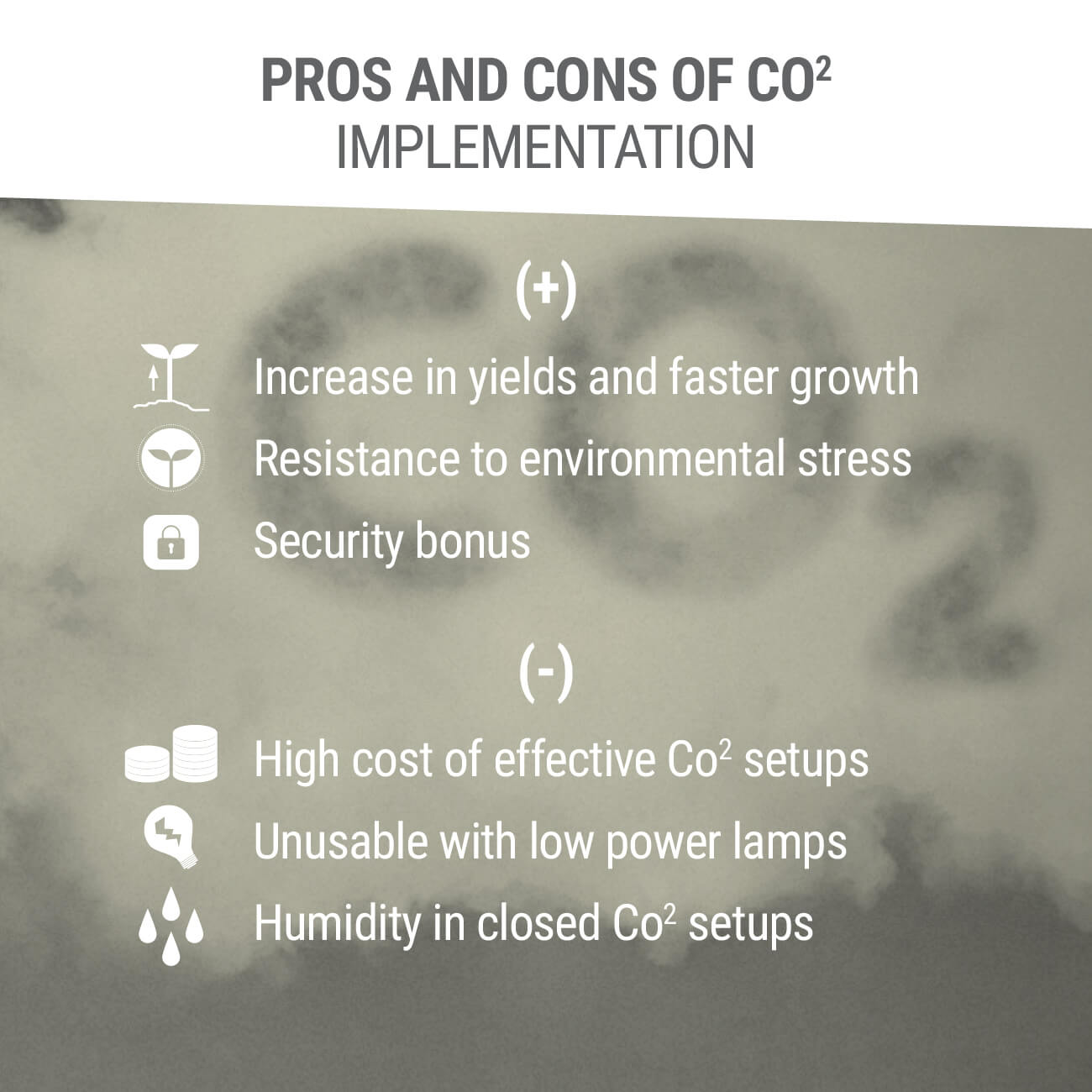
CONS:
-
High Cost Of Effective CO₂ Setups
Any effective method of CO₂ supplementation used today doesn’t come cheap. There is simply no way around this and if you are considering CO₂ enhancement for your garden don’t spare any money. Investing in cheap ineffective CO₂ setup is just a waste of time and money. Even though the initial cost of good quality CO₂ setup is high, the maintenance is actually much cheaper and it will certainly pay off in the long run.
-
Unusable With Low Power Lamps
As mentioned before, CO₂ injection becomes effective only when there’s bright light present. Many growers who are growing with a limited amount of space and light will not benefit from the higher CO₂ concentration. Anything under 600W/m² is considered too low for CO₂ injection. With larger growing space more light is needed.
-
Humidity In Closed CO₂ Setups
Various methods of adding CO₂ to grow room requires sealed setups that have high humidity as a side effect. The increase in heat makes cannabis transpire more, raising humidity levels and setting up a plant for mould and other humidity related problems. It is crucial to keep track of humidity levels in CO₂ setups and ensure proper airflow inside the growing space. Growers who are maxing out the CO₂ injection often use dehumidifiers to control humidity.
When Should You Use CO₂?
First, you should use CO₂ only once you’ve nailed the basics. After you’ve achieved several successful grows, learning to dial in variables such as nutrients and training techniques, you can use CO₂ to push your yields to the maximum.
Don’t use CO₂ during your first few grows thinking you can neglect other fundamental principles while boosting yields for free. CO₂ serves as a way to add a bit more weight to your overall harvest, but you must first be comfortable with providing all of the plant’s other demands.
Once you’re ready to use CO₂, you must administer the gas at the right time. You should only keep your CO₂ enrichment system running during the day. During the vegetative phase, photoperiod plants need at least 16 hours of light each day, and they can only utilise CO₂ while the lights are on.
Switch your system off during the night to save money and gas. Otherwise, you’ll pump CO₂ into your grow tent and it’ll go to waste.
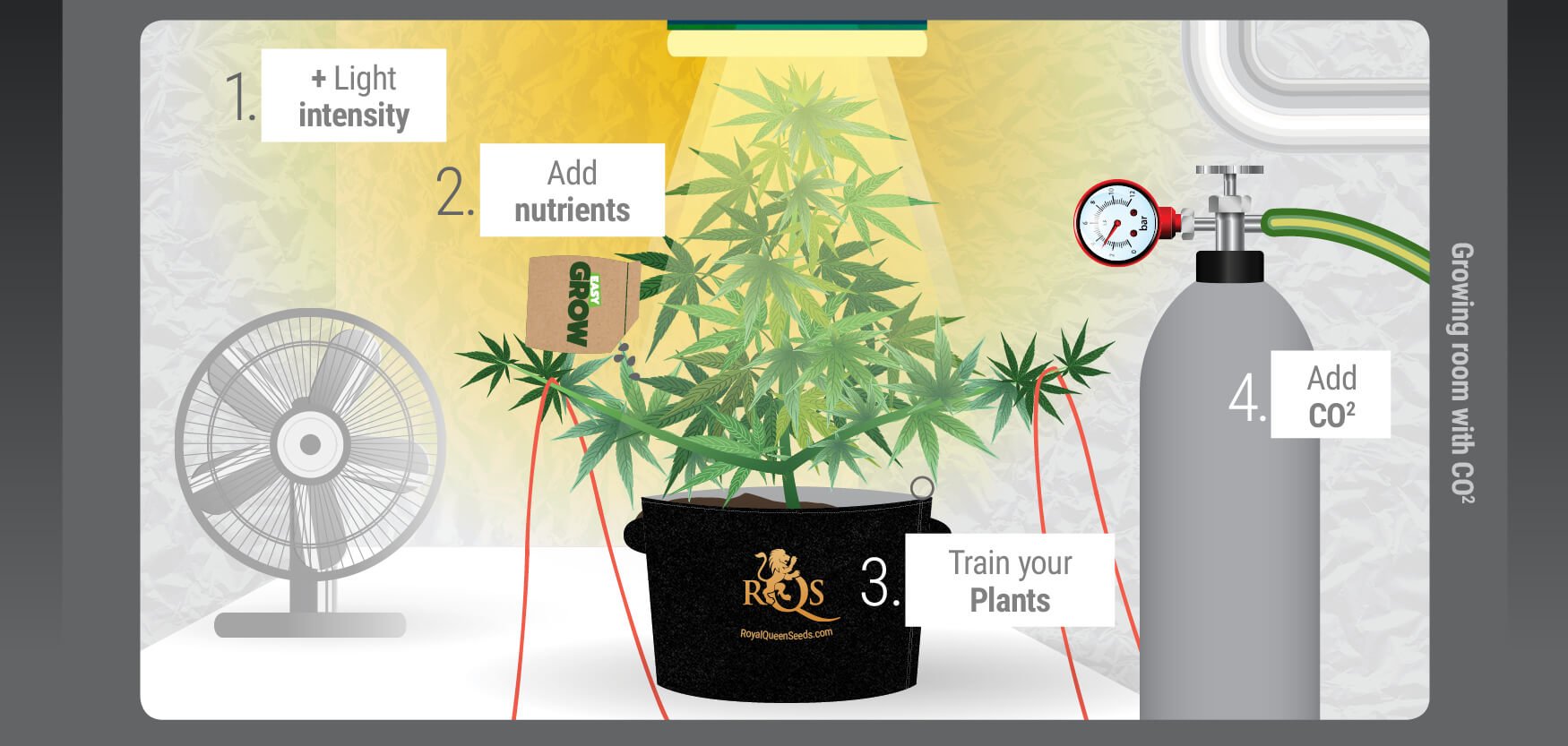
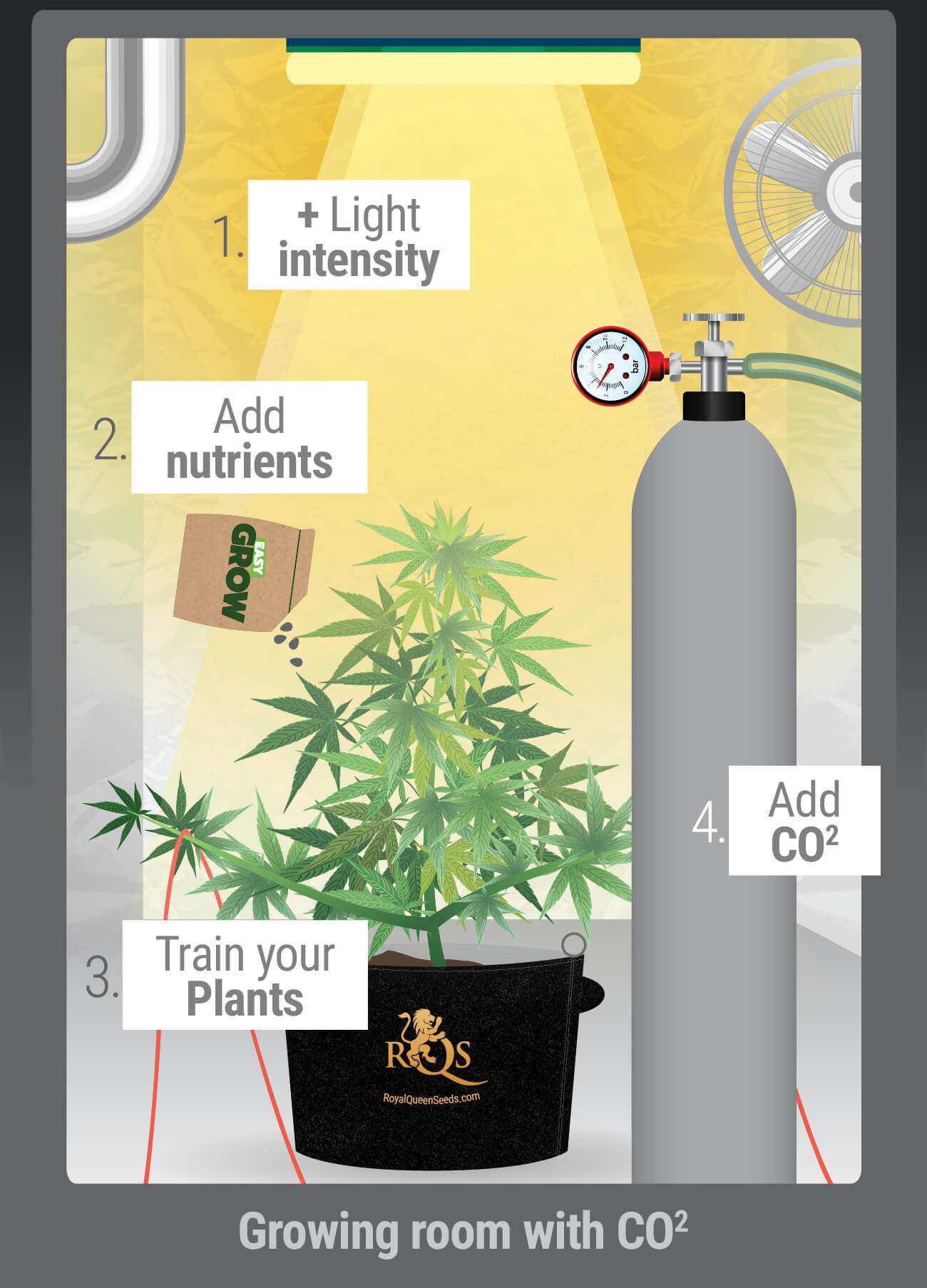
How To Use CO₂ During the Vegetative and Flowering Stages
Cannabis plants require different levels of nutrients and light during different stages of the growing cycle. Their demand for CO₂ also fluctuates at different points of maturity.
Vegetative Stage
CO₂ primarily helps to fuel luscious leafy growth. It comes in handy during the vegetative stage to help plants surge from a seedling into a large plant with many future bud sites and large fan leaves.
The more wide and green leaves a plant possesses, the more chloroplasts it has to convert light into energy, and the more stomata it has to allow the diffusion of CO₂ into its cells. Pump your grow tent with CO₂ during the daylight hours during the entire vegetative stage.
Flowering Stage
Although CO₂ undoubtedly benefits plants during the entire vegetative period, growers differ in their use of the gas during the flowering stage. CO₂ certainly helps to drive floral growth during the first 2–3 weeks of bloom.
However, some growers report diminishing returns during the final few weeks of flowering. For this reason, many growers shut off their CO₂ enrichment systems during the two weeks before harvest. However, others choose to keep the CO₂ flowing in hopes of bigger and better buds.
While this debate remains up in the air, you should simply do what works best for you.
How Much CO₂ Should I Use in My Cannabis Grow Room?
Throwing the figure of 1500ppm around sounds great, but how does that help you know the exact amount of CO₂ you need for your growing tent? Well, that figure serves as the target, and the calculations below will help you achieve it.
Work Out the Cubic Area
Calculate the volume of your grow tent using this equation: length × width × height. For example, a grow tent of 6.5 × 6.5 × 6.5' features an area of 274 cubic feet. In metres, that’s 2 × 2 × 2m = 8m³
Multiply by 0.001
Multiply your cubic area by 0.001 to find out how many cubic metres of CO₂ it will take to inject 1000ppm of the gas into your grow tent. For example, 8m³ × 0.001 = 0.008 cubic metres of CO₂.
Adjust To Reach 1500ppm
1000ppm provides plenty of CO₂, but hitting 1500ppm will fully saturate your growing area. In line with the example above, follow this easy equation:
0.008 ÷ 2 = 0.004
0.008 + 0.004 = 0.012 cubic metres of CO₂
Set Your Pump
When it comes to injecting CO₂ into your growing space (explained below), you’ll need to adjust your system accordingly. Use a CO₂ regulator—attached to a tank—to change the amount of CO₂ entering the space each hour. Set the dial to the sum that you reached after following the equation above.
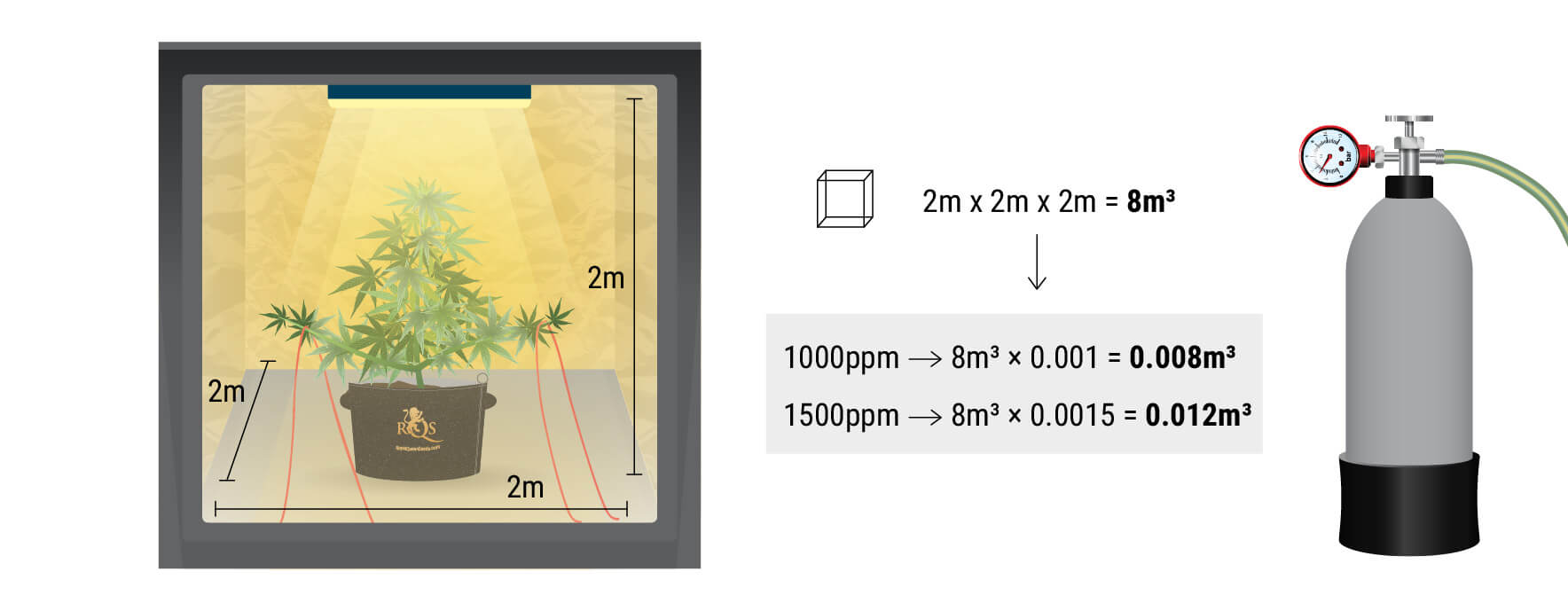
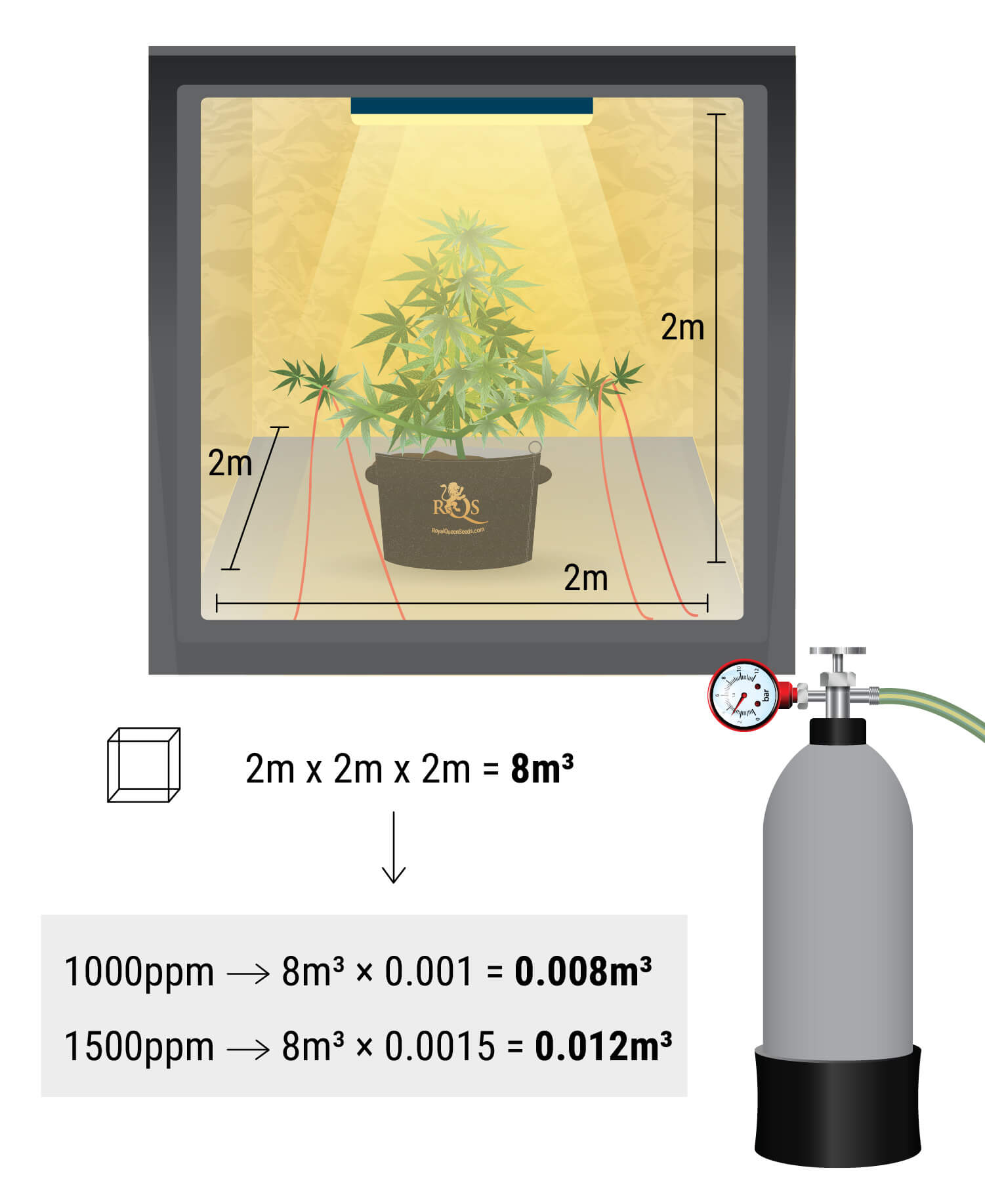
How To Add CO₂ to Your Grow Room
Now that you know how much CO₂ you need, it’s time to start injecting it into your growing room. Find out how to administer it below, and what kinds of systems you can choose from to get the job done.
Seal Your Grow Tent
The law of diffusion states that molecules move from an area of high concentration to an area of low concentration. Because normal air contains CO₂ at only 400ppm, you’ll need to prevent high levels of injected CO₂ from diffusing out of your grow tent. Seal the gaps using duct tape to prevent CO₂ from escaping.
Sealing your growing space also requires paying more attention to variables such as temperature and humidity. Use a thermo-hygrometer to measure both of these factors simultaneously. You can use air conditioning and a dehumidifier to keep both within an ideal range.
When utilising high levels of CO₂, aim for:
- Temperature: 30°C
- Veg humidity: 40–70%
- Flowering humidity: 40–50%
If you’re using hotter HPS lights, fit a hood reflector to keep your bulb from overheating.
Add CO₂ by “Raining” It on Your Plants From Above
Make the most of your CO₂ by “raining” it down on your plants from above. Being heavier than air, CO₂ will sink to the bottom of your growing room. Fit the nozzle of your CO₂ pipe so it injects the gas above your plants. Place a small fan on the floor of your growing tent—pointing upward—to keep CO₂ circulating around the leaves.
If you're using other methods, use shelves or blocks to elevate your CO₂ source above the canopy.
Types of CO₂ Systems
When it comes to boosting CO₂ levels in your grow tent, there are plenty of different systems to choose from. There are more complex and expensive systems such as tanks and generators, and more simple and cheap options that involve baking soda and compost.
CO₂ Tanks
CO₂ tanks are filled with compressed gas. Paired with a CO₂ regulator, they are an easy and efficient way to deliver CO₂ into the growing space.
| PROS | CONS |
| Deliver accurate and measured amounts of CO₂ | Expensive initial investment |
| Simple system | Moving tanks in and out of your house may look suspicious |
| Growers can automate these systems with the help of a controller | May need a licence in some countries and regions |
| - | Incorrect use can lead to the release of excessive levels of CO₂, which can harm humans and pets |
| PROS | CONS |
| Deliver accurate and measured amounts of CO₂ | Expensive initial investment |
| Simple system | Moving tanks in and out of your house may look suspicious |
| Growers can automate these systems with the help of a controller | May need a licence in some countries and regions |
| - | Incorrect use can lead to the release of excessive levels of CO₂, which can harm humans and pets |
CO₂ Generators
These handy devices burn alcohol or natural gas and churn out high quantities of CO₂.
| PROS | CONS |
| Easy to use | Increases temperature and humidity |
| Minimal effort | Can produce dangerous carbon monoxide |
| Efficient and can be automated | Potential fire hazard |
| No need to carry CO₂ tanks in and out of your home | More expensive |
| PROS | CONS |
| Easy to use | Increases temperature and humidity |
| Minimal effort | Can produce dangerous carbon monoxide |
| Efficient and can be automated | Potential fire hazard |
| No need to carry CO₂ tanks in and out of your home | More expensive |
Dry Ice
If you’ve ever been to a nightclub or music concert, you’ve probably seen dry ice in action in the form of a misty substance. Before it turns into a gas, dry ice (solid carbon dioxide) works as a good store of carbon. Growers can use dry ice to release large amounts of CO₂ into their growing space.
| PROS | CONS |
| Cheap initial purchase | Expensive in the long run |
| Doesn’t lead to drastic changes in temperature or humidity | Harder to regulate CO₂ levels |
| - | Must be used straight away and cannot be stored |
| PROS | CONS |
| Cheap initial purchase | Expensive in the long run |
| Doesn’t lead to drastic changes in temperature or humidity | Harder to regulate CO₂ levels |
| - | Must be used straight away and cannot be stored |
Metabolic and Chemical Options
If you’re looking to introduce more CO₂ into your grow tent without much of an investment, or trying to keep your herbal hobby as stealthy as possible, you can also use numerous chemicals and metabolic processes to help boost levels of the gas.
Baking Soda & Vinegar
The combination of baking soda and vinegar leads to a chemical reaction that releases carbon dioxide.
| PROS | CONS |
| Cheap | Needs constant maintenance |
| Easily accessible materials | Reaction doesn’t last very long |
| Doesn’t increase temperatures or pose a hazard | No way to measure the amount of CO₂ produced and released |
| PROS | CONS |
| Cheap | Needs constant maintenance |
| Easily accessible materials | Reaction doesn’t last very long |
| Doesn’t increase temperatures or pose a hazard | No way to measure the amount of CO₂ produced and released |
Buckets or Bags of Compost
Chances are you already use compost to nourish your cannabis plants. As microbes get to work breaking down the organic matter in your pile, small amounts of carbon dioxide are released.
| PROS | CONS |
| Cheap and can be made from food scraps and garden waste | Things can get smelly |
| Relatively stealthy option | Only produces small quantities of CO₂ |
| - | No way of knowing the volume of CO₂ produced |
| - | Can’t turn it "off" at night |
| PROS | CONS |
| Cheap and can be made from food scraps and garden waste | Things can get smelly |
| Relatively stealthy option | Only produces small quantities of CO₂ |
| - | No way of knowing the volume of CO₂ produced |
| - | Can’t turn it "off" at night |
CO₂ Bags
CO₂ bags harness the power of fungi to produce CO₂. These bags contain mycelium (the filamentous body of a mushroom) to break down a bag filled with substrate. As the mushroom secretes enzymes to digest the food, it causes chemical reactions that give off CO₂.
| PROS | CONS |
| Cheap | Requires multiple bags to fill a small grow tent |
| Easy to make at home | Growers need to understand fungi cultivation and sustain correct conditions |
| Environmentally friendly option | - |
| PROS | CONS |
| Cheap | Requires multiple bags to fill a small grow tent |
| Easy to make at home | Growers need to understand fungi cultivation and sustain correct conditions |
| Environmentally friendly option | - |
Fermentation
Yeast releases small amounts of CO₂ during the process of fermentation.
| PROS | CONS |
| Cheap and accessible ingredients | Gives off small quantities of CO₂ |
| Stealthy | Doesn’t deliver an accurate dose |
| Easy process | Can start to get smelly |
| PROS | CONS |
| Cheap and accessible ingredients | Gives off small quantities of CO₂ |
| Stealthy | Doesn’t deliver an accurate dose |
| Easy process | Can start to get smelly |
How To Make Your Own DIY CO₂ System at Home
If you’re interested in the metabolic options mentioned above, check out the two brief guides below to learn how to make your own DIY CO₂ system at home.
DIY Yeast CO₂ System
Using the same type of yeast that causes bread to rise, you can create a fermentation reaction that releases small amounts of CO₂ into your grow tent.
What You’ll Need
- 1 cup sugar
- 11.5 grams brewer’s yeast
- 3 litres warm water
- Plastic jug
- Cling film

Directions
- Mix the ingredients in the jug.
- Place a layer of cling film over the top of the jug.
- Puncture several small holes into the film.
- Place the jug into your grow tent, ideally above your plants on a shelf or stand.
- Keep the tent at around 26–30°C to assist the fermentation process.
- Place a layer of cling film, without holes, over the jug at night to allow the CO₂ to build up, ready for the lights to come back on.
Baking Soda and Vinegar DIY CO₂ System
You can also make your own DIY CO₂ system using a combination of baking soda and vinegar. You likely already have these substances lying around your kitchen, making it the easiest and most accessible way to ramp up CO₂ levels. Because this reaction occurs quickly, you need to continuously drop vinegar onto the baking soda to ensure the constant release of CO₂.
What You’ll Need
- Bottle of vinegar
- Baking soda
- Plastic bottle
- Deep tray
- Pin

Directions
- Fill up a tray with a layer of baking soda and place it high up in your grow tent.
- Take your plastic bottle and pin, and make several tiny holes in the bottom of the bottle.
- Place the bottom of the bottle on the baking soda and fill with vinegar.
- Apply the plastic bottle cap.
- Allow the vinegar to slowly enter the tray over the course of the day.
- Turn your plastic bottle upside down at night to pause the reaction.
- Repeat this process every couple of days.
External Resources:
- Effect of increasing temperature on crop photosynthesis: from enzymes to ecosystems | Journal of Experimental Botany | Oxford Academic https://academic.oup.com
Disclaimer:
This content is for educational purposes only. The information provided is derived from research gathered from external sources.


























